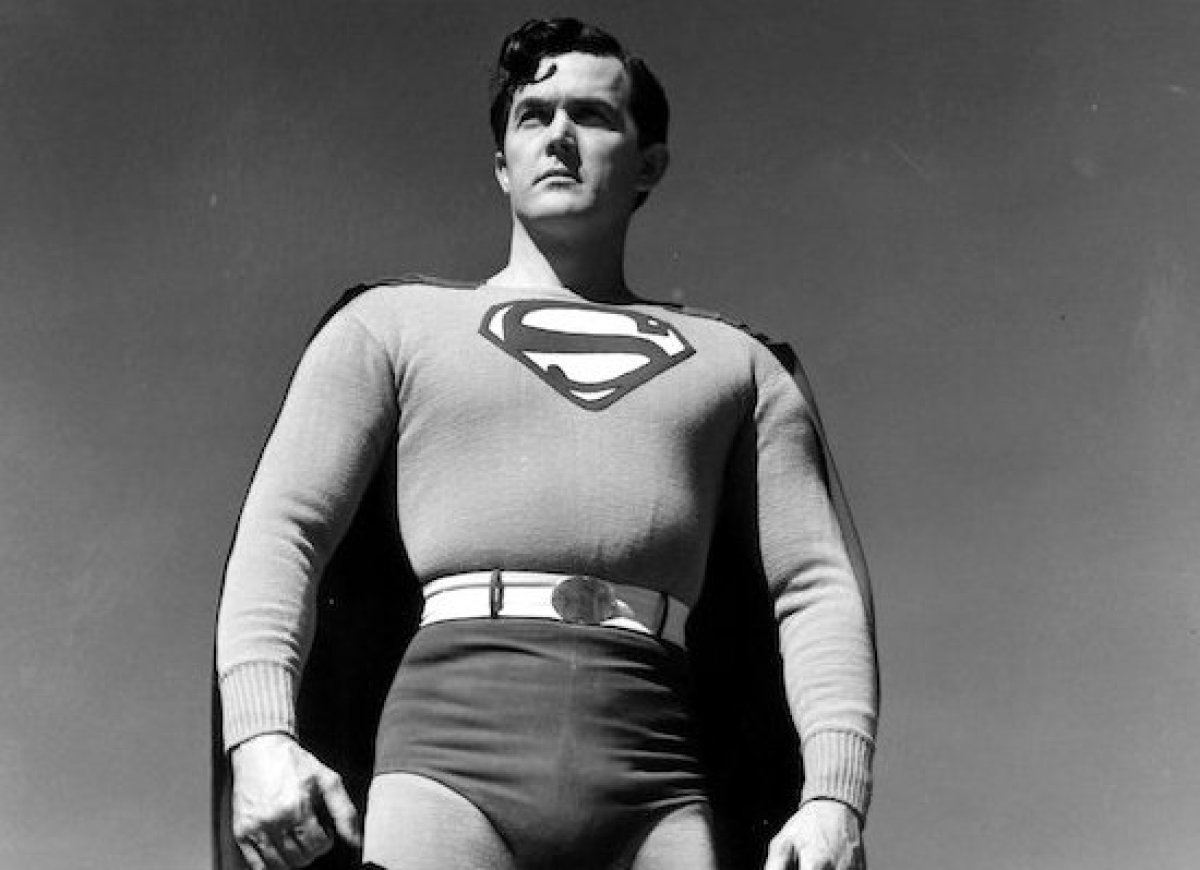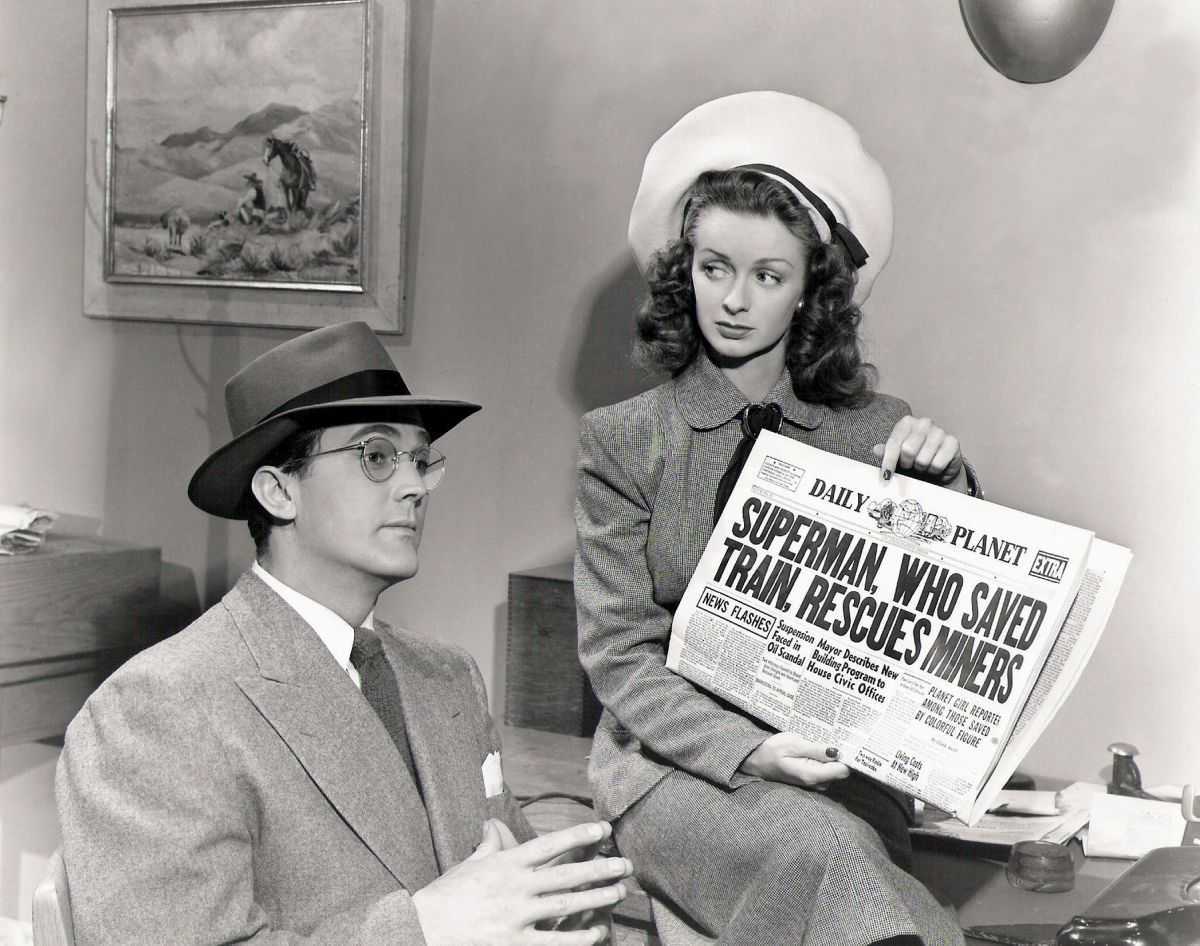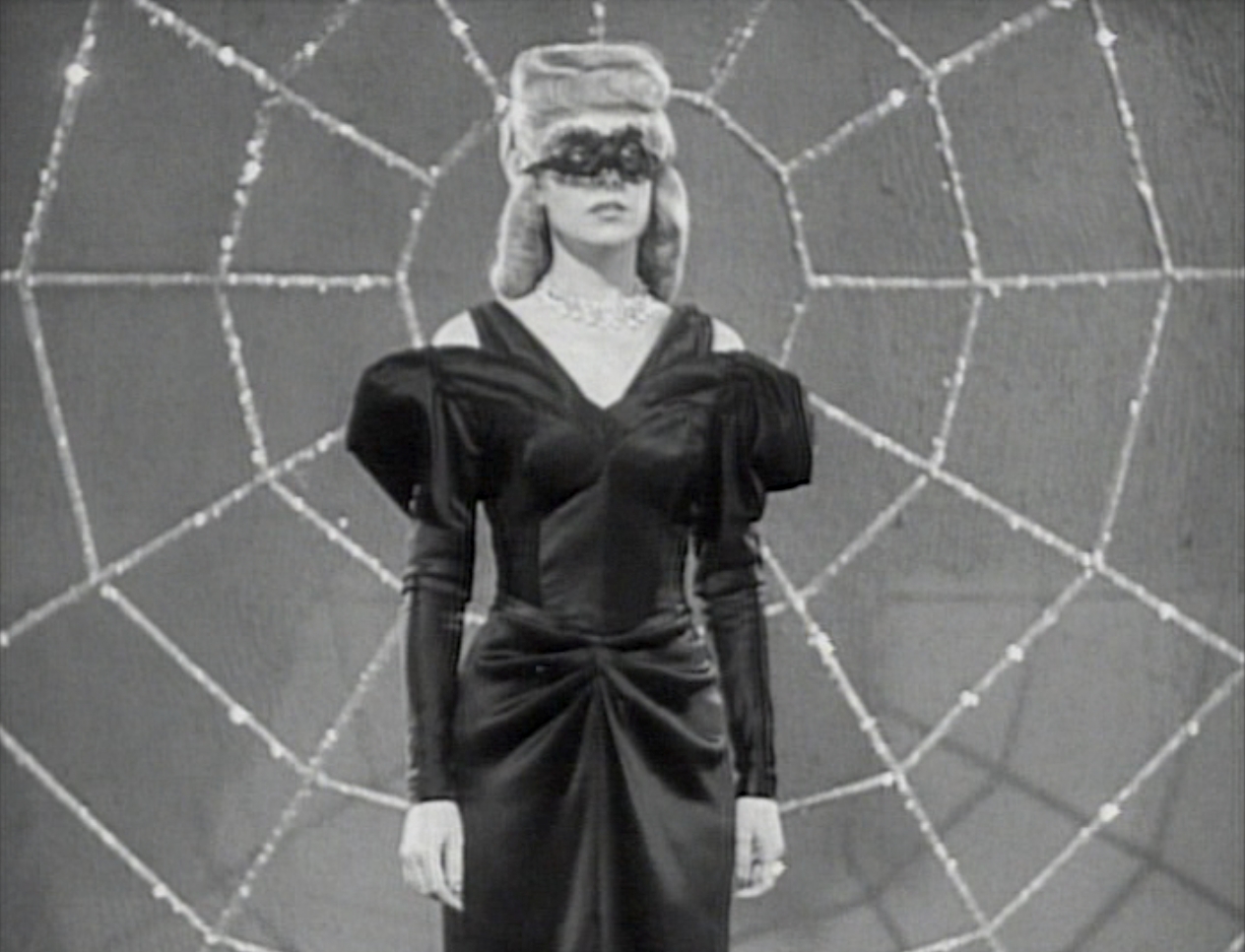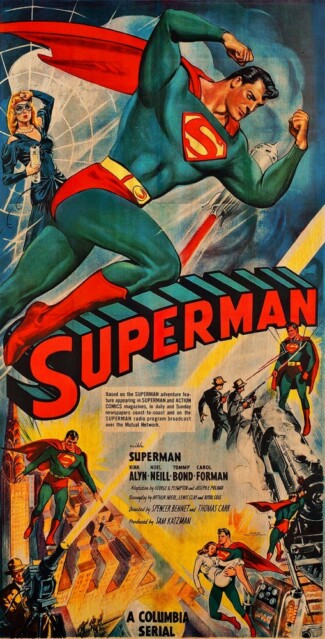USA. 1948.
Crew
Directors – Spencer Bennet & Thomas Carr, Screenplay – Lewis Clay, Royal Cole & Arthur Hoerl, Adaptation – George H. Plympton & Joseph F. Poland, Based on the Comic-Book Created by Joe Shuster & Jerry Siegel and the Radio Series The Adventures of Superman, Producer – Sam Katzman, Photography (b&w) – Ira H. Morgan, Music Director – Mischa Bakaleinikoff, Art Direction – Paul Palmentola. Production Company – Columbia.
Cast
Kirk Alyn (Superman/Clark Kent), Noel Neill (Lois Lane), Carol Forman (The Spider Lady), Tommy Bond (Jimmy Olsen), Pierre Watkin (Perry White), George Meeker (Driller), Charles Quigley (Dr Hackett), Herbert Rawlinson (Professor Graham), Jack Ingram (Anton), Terry Frost (Brock)
Plot
On the planet Krypton, the scientist Jor-el determines that their world is on a collision course with its sun. The planetary council ignores his warnings and so he and his wife place their infant son in a small rocket and launch it just before Krypton is destroyed. The rocket comes down on Earth where the infant is found and adopted by Eben and Martha Kent. As he grows up, the child, named Clark, demonstrates great strength and many other powers as a result of his alien origin. Growing into manhood, Clark Kent sets out to Metropolis and obtains a job as a newspaper reporter with The Daily Planet. Hiding behind glasses and a shy manner, he emerges in a costume as Superman and uses his powers for good. He soon comes up against the criminal mastermind known as The Spider Lady who is determined to obtain the Relativity Reducer Ray. As Superman foils numerous of her schemes, The Spider Lady discovers he has a vulnerability to one thing – Kryptonite, radioactive shards from his homeworld that are harmless to humans but prove deadly to Superman.
This fifteen chapter serial should be considered the very first ever appearance of Superman on the screen. (In live-action at least – there had previously been seventeen animated Superman short films produced by Max Fleischer and Famous Pictures between 1941 and 1943). The original Superman comic by Jerry Siegel and Joe Shuster had only appeared a decade before in Action Comics #1 in 1938 and had created the comic-book superhero. It becomes apparent as you watch Superman that more so than the comic-book, the serial has been derived from the radio show Adventures of Superman (1940-51), which starred Bud Collyer. The credits for the serial state that it is based both on the radio show and “the magazine” (wit no mention whatsoever of the comic-book). Certainly, the radio show was far more influential on the evolution of the Superman mythos than one was previously aware – both the regular ongoing comic-book characters of Perry White and Jimmy Olsen were introduced there, for instance. The serial also incorporates some of the radio show’s regular catchphrases “This is a job for Superman” and “Up, up and away.”
The opening chapter Superman Comes to Earth does a fine job of encapsulating the essence of the Superman origin story and faithfully telling it the way it existed in the Golden Age – Krypton as a world of Grecian idealism, Jor-el’s warnings being ignored by the council, the launch of the rocket and the infant’s adoption by the Kents and being raised to manhood. (About the only point of difference is Clark Kent’s stepfather being named Eben rather than the canonical Jonathan, although it should be noted that the Kent backstory was never properly fleshed out in the comic-books until 1948 and Kent Sr did not receive the name Jonathan until 1950). All the essential aspects of the origin story are covered, setting the second chapter up to deal with the first appearance of Superman.
On the other hand, the first appearance of Kirk Alyn as Superman is slightly underwhelming. One must remember that one is watching the serial in 2012 as opposed to 1948 and viewing it through the filter of not only numerous other Superman films and tv series, all being made with much higher budgets, but an entire industry of superhero films that have pushed the boundaries of on-screen superheroics about as far as it is possible to take them.

You are unable to stop comparing the low horizons the superheroics here operate on with what has come since. Things would have been vastly different for audiences back in 1948. Here Superman’s first exploit is to jump out and stop a runaway train. This is not a bad exploit for Superman – they even included a variant of it in the first Christopher Reeve film Superman (1978). However, rather than flying in and saving the day, Kirk Alyn merely changes behind a bush then runs out from behind in Superman costume. Where Christopher Reeve’s Superman went to the extent of using his body as a rail and allowing the train to cross it, Alyn merely bends the rail into place then leaves the scene.
The biggest disappointment is the cheap corner-cutting of the special effects – whenever Superman takes to the air, he becomes represented by an animated figure (courtesy of the Fleischer studio). Evidently animation was cheaper than the cost of any optical or physical wire effects to depict Kirk Alyn taking off and landing. Even things such as the bullets that bounce off Superman’s chest or the images of him bursting through a rock wall have been animated. Not merely satisfied with cutting corners by animating Superman’s flight, some of the same flying shots have also been reused in different chapters. There are a couple of superheroic feats that come off reasonably well – one where Superman catches a missile fired at him in his hand and throws it back at the henchmen; and where Kirk Alyn flies down and stands in front of and stops an oncoming train (even though the rear-projection work of the train is obvious).
Up until the 1970s and the point of the Christopher Reeve Superman, filmed superheroes always had an uncertainty when it came to allowing them to be superheroes. The plots in the other comic-book adapted serials such as Adventures of Captain Marvel (1941), Batman (1943), The Phantom (1943), Captain America (1944) and tv shows such as Adventures of Superman (1952-8), The Six Million Dollar Man (1973-8), The Amazing Spiderman (1977-9), The New Original Wonder Woman (1976-9) and The Incredible Hulk (1977-81) only ever seemed to pit the superheroes against mundane criminals rather than super-villains and substituted world saving heroics with routine cop show plots. (In the case of the wartime serials, the superheroes were frequently co-opted into the fights against Axis powers). The sole exception might be tv’s Batman (1966-8) but there the super-villains were clearly intended in a non-serious way.

The Spider Lady could have made for a worthy super-villain but the serial fails to write her in any interesting way – she is simply a mob boss who wears an evening gown. Apart from one chapter, she remains in her lair for the duration, only relaying orders to lackeys by radio. The writers even fail to make anything of her being a Spider Lady in the same way that characters like Batman, Spider-Man and Cat Woman are given costuming and powers based around their particular animal motifs. About the sole larger than life touch is her having a wall-sized electrified web in her lair, which is good for disposing of recalcitrant lackeys and pinning Lois to in one cliffhanger. Carol Forman gives a performance that fails to vamp the part up in any interesting way either.
The plot is along the lines of a typical serial where the drama is extruded out via races to obtain pieces of gadgetry, formulas or essential chemicals needed to make the central McGuffin device work. (This is the Relativity Reducer Ray, although it is never clear what it actually does – something about a device to focus cosmic rays and project them long distance). To its credit, the serial does introduce Kryptonite part way in and various episodes centre around The Spider Lady trying to lay her hands on it to defeat Superman. The script does conduct a number of considerable cheats at various points. In one scene, one of the hoods tells the Spider Lady “there’s a scientific way to make him [scientist Herbert Rawlinson] obey our every command” – and then in the next scene we see that they have so reprogrammed him via some type of mind control. Alas, the means whereby this is done have been entirely omitted, which makes for sloppy sleight-of-hand plotting. The other cheat might be the climactic scenes where Superman finally ventures into the Spider Lady’s lair but is defeated by her Kryptonite – only to reveal a few minutes later that he has been playing possum, having had the foresight to line his costume with lead.
The serial does nothing particularly outstanding with any of its cliffhangers. The sole exceptions to this might be one scene where Jimmy Olsen hides in a crate in the back of a truck, only for the hoods to find him there and pepper the crate with machine-gun bullets and another sequence where Perry White engages in a great room-wrecking fistfight with a hood in his office and is punched straight out the window to his apparent death.
Kirk Alyn makes for a passable Superman – his body language is somewhat weak but he plays the part with a reasonable certainty and an imperturbable cheer. He does okay, although never seems to inflate the role with the larger than life heroism of a George Reeves or the sincerity of a Christopher Reeve. What must be said is that Alyn does undergo a remarkable chameleon shift in switching between the roles of Superman and Clark Kent and manages to nail the “gee shucks” milquetoast nature and dull straightness of Clark perfectly. (One of the oddities of the dual roles is that when Kirk Alyn dons the hat, glasses and double-breasted suit as Clark Kent, it makes him look Alyn’s natural 6’1″ height, whereas in the Superman costume Alyn comes out physically more puny and only about 5’6″ in height). One of the best pieces of casting is Noel Neill’s Lois Lane. Neill gives the part just the right degree of peppery determination and feistiness that it makes the character of Lois and her relationship with Clark work as it should. Indeed, the relationship between the two of them here is possibly the one occasion where film and tv manage to capture the Clark-Lois-Superman triangle the way the Golden and Silver Age Superman comics wrote it better than any other.

Kirk Alyn, Noel Neill, Tommy Bond and Pierre Watkin all returned in a sequel Atom Man vs. Superman (1950), which introduced the first screen appearance of Lex Luthor. Noel Neill was also reappeared as Lois Lane, replacing Phyllis Coates in the role, from the second season onwards in the classic tv series Adventures of Superman (1952-8) with George Reeves. Both Kirk Alyn and Noel Neill made cameo appearances as Lois Lane’s parents in the first Christopher Reeve Superman film. These were cut from the original print, apart from one minor scene with a couple and child looking out the window of the train where it is never made clear who they are, but this is restored in extended versions of the film. Kirk Alyn passed away in 1999 but Noel Neill makes a further appearance as the aging dowager that Lex Luthor rips off in Bryan Singer’s Superman Returns (2006).
Spencer [Gordon] Bennet (1893-1987) was a prolific director who began work in the silent era. He became known for assorted Westerns and numerous other serials. His other genre works include:- G-Men vs the Black Dragon (1943), The Masked Marvel (1943), Haunted Harbor (1944), The Tiger Woman (1944), Manhunt of Mystery Island (1945), The Purple Monster Strikes (1945), The Black Widow (1947), Brick Bradford (1947), Batman and Robin (1949), Bruce Gentry (1949), Atom Man vs. Superman (1950), Captain Video (1951), Mysterious Island (1951), Blackhawk (1952), The Lost Planet (1953), all of which are serials, plus the feature-length Voodoo Tiger (1952), Killer Ape (1953) and The Atomic Submarine (1959).
Other Superman appearances on screen are:-
- seventeen Superman animated shorts produced by Fleischer Studios between 1941 and 1943
- the low-budget feature film Superman and the Mole-Men (1951), which became the basis of the long-running tv series Adventures of Superman (1952-8) starring George Reeves
- It’s a Bird … It’s a Plane … It’s Superman (1975), a tv movie adapted from a Superman Broadway musical starring David Wilson
- the big-budget Superman (1978) starring Christopher Reeve, which led to three sequels with Superman II (1980), Superman III (1983) and the cheap Superman IV: The Quest for Peace (1987) from Cannon Films, as well as spinoffs like Supergirl (1984) starring Helen Slater and tv’s Superboy (1988-91) starring Gerard Christopher. Also of interest here is Superman II: The Richard Donner Cut (2006), Richard Donner’s edit of his original intended vision of Superman II, which had been subject to much in-fighting with the producers
- Lois and Clark: The New Adventures of Superman (1993-7), a popular tv series that focused more on the love triangle relationship between Clark/Superman (Dean Cain) and Lois Lane (Teri Hatcher)
- the excellent animated series Superman (1996-2000) where the superheroic exploits were rendered in a beautifully stylised Art Deco milieu, which led to several spinoff films with Superman: The Last Son of Krypton (1996), The Batman Superman Movie: World’s Finest (1998) and Superman: Brainiac Attacks (2006), while Superman also appears as one of line-up of DC superheroes in the same creative team’s Justice League/Justice League Unlimited (2001-6)
- The DC Universe Original Animated Films:- Superman: Doomsday (2007), Superman/Batman: Public Enemies (2009), Superman & Batman: Apocalypse (2010), All-Star Superman (2011), Superman vs. The Elite (2012), Superman Unbound (2013), The Death of Superman (2018), Reign of the Supermen (2019), Superman: Man of Tomorrow (2020), Superman: Red Son (2020) and Batman and Superman: Battle of the Super Sons (2022), while Superman also appears in Justice League: The New Frontier (2008), Justice League: Crisis on Two Earths (2010), Justice League: Doom (2012), Batman: The Dark Knight Returns Part II (2013), Justice League: The Flashpoint Paradox (2013), Justice League: War (2014), Justice League: Throne of Atlantis (2015), Justice League: Gods and Monsters (2015), Justice League vs Teen Titans (2016), Justice League Dark (2017), Justice League vs The Fatal Five (2019), Justice League Dark: Apokolips War (2020), Injustice (2021), Justice Society: World War II (2021), Justice League: Warworld (2023), Legion of Super-Heroes (2023) and Justice League: Crisis on Infinite Earths Part One (2024)
- the tv series Smallville (2001-11) played by Tom Welling, which concerns Superman’s teen years
- Bryan Singer’s follow-up to the Christopher Reeve films Superman Returns (2006) starring Brandon Routh and Superman: Requiem (2011), a feature-length fan film starring Martin Richardson that was sanctioned by Warner Brothers
- Zack Snyder’s reboot Man of Steel (2013) starring Henry Cavill and its follow-ups, the DC superhero team-ups Batman V Superman: Dawn of Justice (2016) and Justice League (2017) and the extended cut of the latter with Zack Snyder’s Justice League (2021), while Cavill also makes a cameo in the end credits of Black Adam (2022)
- the tv series Supergirl (2015-21) starring Melissa Benoist with appearances from Tyler Hoechlin as Superman who was later given his own series with Superman and Lois (2021– )
- the prequel tv series Krypton (2018-9) concerning Superman’s grandfather before the destruction of Krypton
- Superman also turns up as an animated character in Legion of Superheroes (2006-8), The Lego Movie (2014), The Lego Batman Movie (2017), Teen Titans Go! To the Movies (2018), The Lego Movie 2 (2019) and DC League of Super Pets (2022), while the animated series Young Justice (2010-3) features Superboy, a clone of Superman, as a regular character
- Also of interest is The Death of “Superman Lives”: What Happened? (2015), a documentary about the aborted Tim Burton-Nicolas Cage Superman film of the late 1990s, and the South Korean A Man Who Was Superman (2008) about a man who believes he is Superman.
Trailer here

